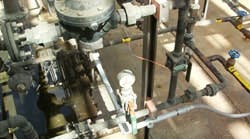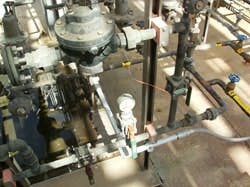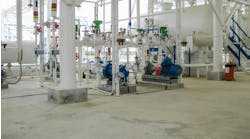Leaks of compressed air and gases like nitrogen, carbon dioxide and refrigerants can waste significant amounts of energy, e.g., because compressors must run harder to maintain pre-set pressures. In addition, such leaks can pose broader negative impacts — on the overall plant, the environment and, quite possibly, the well-being of the personnel.
Air leaks can compromise the performance of control and pressure-reducing valves that play essential roles in processing and so can cause impacts far from the leaks. At some sites such as biotech facilities, compressed air may regulate ambient humidity and temperature in critical research and production areas; leaks could lead to environmental excursions that ruin months or years of work.
Other gases are quite a bit more expensive than compressed air. As a rule of thumb a nitrogen leak typically is ten times more costly than an air leak. So living with many nitrogen leaks will take a big bite out of your profits. For a volatile gas such as natural gas, identifying and repairing the leak becomes an urgent priority. The potential safety hazard far outweighs actual gas cost. Inert gases such as argon, helium and nitrogen aren’t toxic and don’t burn or explode. However, they can cause injury or death at high concentrations by displacing oxygen in the air. Leaks of carbon dioxide add to the environmental problem of “greenhouse gases” and so may pose regulatory issues in the future.
Clearly, performing leak audits on a regular basis makes sense.
Comprehensive Evaluation
A proper audit looks at all components of a compressed air or gas system. It should validate operation of critical components. It also should scan and leak-test non-critical components such as relief and solenoid valves, flange gaskets, filter/lubricator/regulators, and threaded, welded and quick-connect fittings and devices.
Compressed air systems should supply clean dry air — and this depends upon the condition of drain traps in the condensate system. A trap failing in the closed position causes condensate backup. Air fed to the system will contain water that can harm equipment. A failed-closed trap also can lead to problems from dirt and corrosion. A trap failing in the open position wastes large quantities of energy. Because most traps are piped into discharge manifolds and then to waste drains, it’s not generally visually apparent that they might have failed open.
Valves, solenoids and other sensitive equipment can plug or stick in an open position and eventually fail. Gaskets between banks of solenoids often begin to leak when water hasn’t been drained from the compressed air system. Sometimes oil carried by the air can cause O-ring or gasket failures. Air lines and other equipment outdoors subject to low temperatures can freeze, leading to cracks and permanent damage.
It’s crucial to find and correct leaks before a small problem becomes severe. In our business there’s an old truism: “Everything leaks, it is just a matter of when.”
Doing without a leak identification and repair program will add a hidden cost to production that can negatively impact your company’s competitiveness and profitability. Plus, as we’ve noted, leaks can pose safety and environmental issues.
Common Questions
A number of questions regularly arise about audits. So, let’s answer them right now:
Is an air/gas leak audit cost effective even in a smaller plant? Yes. Leak detection pays off for any size plant. Leaks can represent a proportionately more important impact on competitiveness in smaller plants, and a substantial actual cost in larger plants.
When we perform an audit in a large plant, we typically find losses of $5,000/day to $10,000/day or more from leakage. Once you get a handle on your leaks, it’s not unusual to be able to shut down one compressor.
How often should a leak audit be performed? Conduct one at least yearly; most plants can justify a semi-annual audit — losses uncovered typically pay for the cost of the audit many times over.
How can a plant improve its leak detection efforts? When leaks become large enough you can hear them. So, heighten awareness of people in each department. Ask them to report audible leaks. If you don’t already own ultrasonic leak-detection units, consider purchasing such equipment and training one or more individuals in each department to perform audits. Recognize these air/gas leak auditors as “energy conservation champions.”
Find All The Leaks
It’s possible to feel or hear some leaks. Indeed, an easy way to confirm the existence of large leaks is to hold a slightly moistened hand near the leak site; the cooling effect will be immediately felt. To spot other leaks, rely on a device that detects the ultrasound produced by a leak.
Chemical processing facilities generally use a copious amount of nitrogen gas in addition to instrument air. Depending on the chemicals being produced, mandatory breathing-air hookup stations may be located at strategic points. Performing a leak audit may involve dealing with unique equipment and processes. For instance, to help prevent hazardous emissions, pumps may incorporate gas-lubricated double seals. These seals use dry nitrogen as a barrier gas to prevent process fluid leakage to the atmosphere. Pressurized stainless steel seal pots beside each pump have many fittings and connections that require ultrasonic scanning. Leaks may appear at threads, misaligned ferrules or where galling of stainless steel fittings has occurred. Because pressures are carefully regulated at each pump, there should be filter/lubricator/regulators — each needs to be scanned.
Tips and tricks. The Allen screw on the opposite side of a pressure regulator gauge can loosen, typically due to vibration or lack of factory-applied sealant, resulting in a leak. Other important areas to check include packing glands of small shut-off valves and shaft seals of air- or gas-operated process valves. In addition, carefully scan relief valves, nitrogen blanket vents, liquefied gas pumps, manhole covers on vessels, flange gaskets, solder joints, hoses, tubing connectors and quick-connect fittings. Don’t overlook overhead lines (Figure 2). Parabolic microphones can help there. They increase the range of standard scanners, enabling leaks to be pinpointed without climbing into labyrinths of overhead piping.
Unique challenges. The corrosive environments typical of many chemical processes can cause leaks. For example, a facility near the ocean discovered that piping for nitrogen distribution had deteriorated from the saltwater mist — leading to a whopping energy loss of $600,000/year from hundreds of pinholes.
Most chemical plants have extensive networks of steam and product piping beside cable and tubing trays. Many times contractors don’t properly secure tubing for compressed air or inert gas. If tubing touches un-insulated steam piping, it melts and creates a large leak.
Plastic tubing can experience a number of other problems. Sometimes small snap rings loosen at the connection points to air-operated valves. This can happen because too much oil or other contaminants are present in pressurized gas or because of vibration. Over time plastic tubing can develop pinholes or splits due solely to age or proximity to specific chemicals.
Many sites use air-operated double diaphragm pumps. Check the center shifting mechanism of the pumps and elastomeric gaskets for leakage. Such leaks can lead to substantial losses. Likewise, scan air-powered motors and mixers to determine if gaskets or shafts are leaking.
Individual solenoids and banks of solenoids need to be scanned. A solenoid can suffer external or internal leakage. An airborne scanning module can uncover external leaks. The auditor can use a stethoscope module to listen for an internal leak in solenoids that may be fully or partially stuck in open position.
Extensive use of air or inert gases leads to many air switches and shut-off valves at plants. Check the air switches for gasket-deterioration leaks and ball valves for packing leaks under their handles.
Many facilities operate waste-heat boilers fueled by chemical byproducts. Tubing and other plastic components, such as bowls of air filters, close to these boilers can become intensely hot, causing rupture points in tubing and gasket failure at filter-bowl seal points. For instance, a massive amount of nitrogen recently was discovered leaking from a filter bowl located a few feet above a waste boiler. There was so much ambient noise in the room from the boiler that the leak went unnoticed for years. The ultrasonic scan allowed its identification at least fifty feet from the leak site.
Keys to Success
Success of a leak survey depends upon three major elements: knowledge, planning and follow-through.
You must have a good understanding of the compressed air or gas system, including all subsystems and components. What are the sizes, types and ages of compressors? Have they been properly maintained? What about traps and drains? Are pressure gauges working and, if so, is pressure adequate for various areas of use? What are assigned pressures for these areas? Can you replace any compressed air applications with alternative less-energy-intensive methods? For example, instead of relying on compressed air for cooling, drying or cleanup, consider low-pressure blowers or fans.
Knowledge also can include familiarity with the ultrasound instrument and techniques of inspection. If staff aren’t too sure about the technology or how to use the instrument, take advantage of available training courses to increase competence and effectiveness.
Planning has a number of facets. You should develop or update a map of the compressed gas system and its various components. If no map exists, take digital photographs of each section using long-range and close-up views and carefully label them. Planning also includes scheduling the survey. Don’t try to do it all at once. Arrange assignments so they don’t negatively affect other maintenance responsibilities of the personnel on the leak team.
[sidebar id="3"] Before the survey begins, inspectors should walk through the various sections to review their route. This walk-through can help in a number of ways: it can identify potential safety issues; suggest changes needed to the planned route; pinpoint obvious leaks; and clarify what equipment such as flashlights, keys or specialized leak-inspection attachments to bring along.
Another important aspect of planning is setting up a leak tag/identification method (Figure 1). Tag every leak found. Use the tag number, along with a photograph of the leak, in your report — and assign a leak rate that can be used to demonstrate the economic and potential environmental impact of the leak.
Follow-through also is crucial. An un-repaired leak continues to cost the plant money both directly and by wasting the effort and cost of the survey. The shear volume of identified leaks can seem overwhelming to a maintenance department, especially one already hard-pressed to handle its regular work. So, establish a realistic method to ensure repair of all identified leaks. For instance, prioritize repairs so the most costly leaks or those that can affect production are done first, the next most important later, and so on. In addition, check the repair — sometimes it might cause another leak to appear elsewhere or the wrong component has been “repaired.”
Record-keeping is another important element of follow-through. Some companies provide software that can help. For instance, a freeware program offered by UE Systems combines data management and comprehensive compressed-gas-survey analysis. Users can review annualized and monthly data that include leak cost and greenhouse gas savings. Such data on economic and environmental impact allow generating a report that demonstrates the effectiveness of the survey and the related cost savings.
Stopping Leaking Cash
Leaks incur obvious extra costs in producing or purchasing compressed gases. They also pose hidden costs. Safety and environmental issues, equipment degradation caused by leaks and equipment inefficiencies can add up in many ways. A planned, comprehensive leak-survey program can provide savings that can improve plantwide productivity, competitiveness and profitability.
Bruce Gorelick is vice president of Enercheck Systems, Charlotte, N.C. Alan Bandes is vice president, marketing, for UE Systems, Inc., Elmsford, N.Y. E-mail them at [email protected] and [email protected].



